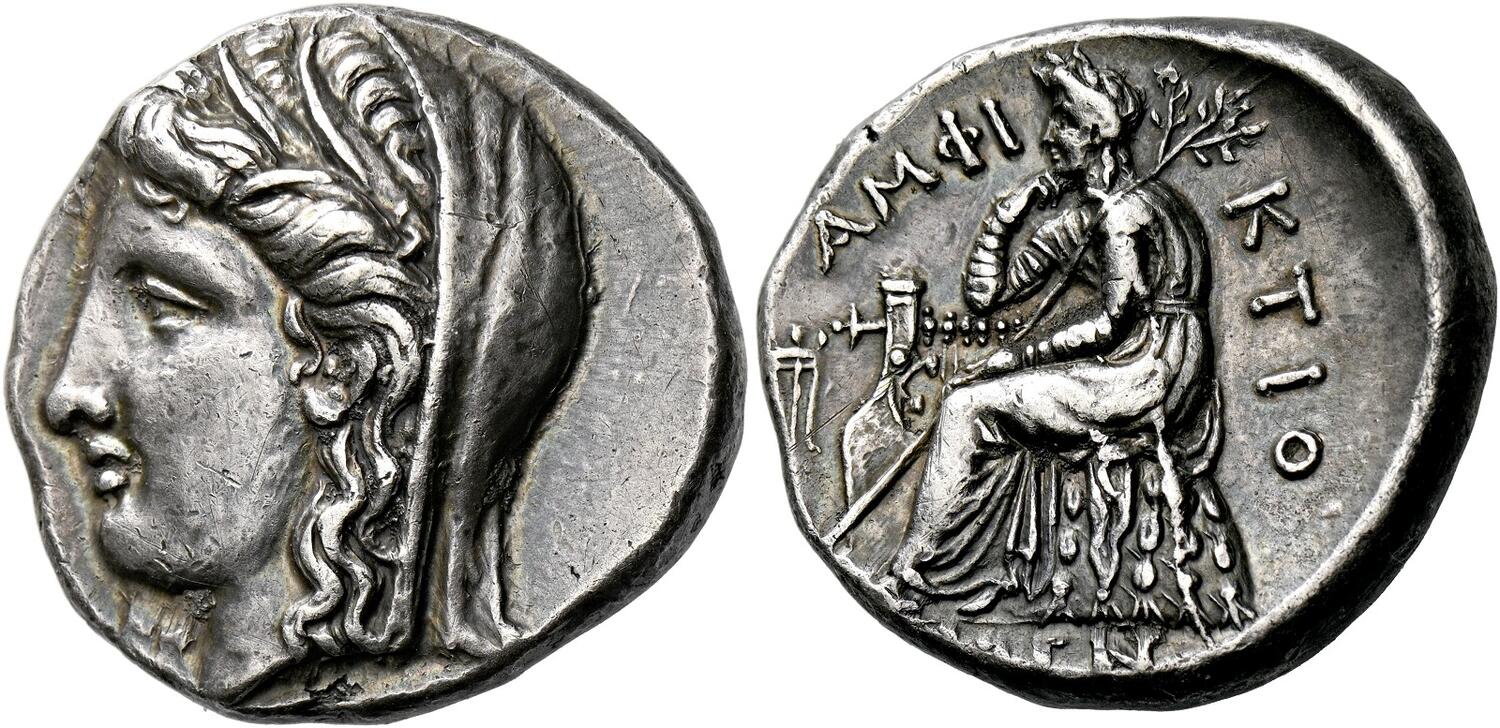Delphi, silver, staters (Demeter/Apollo) (336-334 BCE)
From SILVER
336 BCE - 334 BCE Silver 2,028 kg
Description
| ObverseInscription or printing placed on the obverse.: | Veiled head of Demeter l., wearing a wreath with ears of wheat and reeds. |
| ReverseInscription or printing placed on the reverse.: | AMΦΙKTIONΩN (Greek).Apollo Pythios, laureate and wearing chiton, seated l. on omphalos draped with himation, his r. elbow rests on lyre and his r. hand supports his chin, a long laurel branch rests diagonally across him. |
Mint and issuing power
| MintIdentifies the place of manufacture or issue of a numismatic object.: | Delphi | Ancient regionAncient region.: | Phocis | Modern countryModern country: Greece | AuthorityIdentifies the issuing power. The authority can be "pretended" when the name or the portrait of X is on the coin but he/she was not the issuing power. It can also be "uncertain" when there is no mention of X on the coin but he/she was the issuing power according to the historical sources: | Amphictyonic league |
Chronology
| FromIdentifies the initial date in a range assigned in a numismatic context. | 336 BCE | toIdentifies the final date in a range assigned in a numismatic context.. | 334 BCE | PeriodTime period of the numismatic object.: Classical 480-323 BC |
Physical description
| MetalThe physical material (usually metal) from which an object is made.: | Silver |
Median weightMedian of the weights of numismatic objects (in grams). in grams | 12.20 | DenominationTerm indicating the value of a numismatic object. Examples: tetradrachm, chalkous, denarius.: | stater |
StandardStandard.: |
Image

H146 Demeter Apollo.jpeg [1]
References
| Die study referencePublication of the study: | Kinns 19831Kinns 1983 | ||
| Coin series referenceReference to coin series study: | RQEMH2RQEMH, n° 146, HGC 43HGC 4, n° 1140 | ||
Obverse dies distribution
| FrequencyFrequency of specimen in distribution. ᵖ | Number of obversesNumber of obverse dies. ᵖ (o) | % (o) | Number of coinsNumber of coins. (n) | % (n) | Die nameName(s) of the die(s). |
| 1 | 2 | 28.57 | 2 | 7.69 | 5, 6 |
| 2 | 1 | 14.29 | 2 | 7.69 | 3 |
| 4 | 2 | 28.57 | 8 | 30.77 | 2, 7 |
| 5 | 1 | 14.29 | 5 | 19.23 | 4 |
| 9 | 1 | 14.29 | 9 | 34.62 | 1 |
| Total | 7 of 7 | 100.01 | 26 of 26 | 100 |
Reverse dies distribution
no distribution is available
Quantification
| Number of obversesNumber of obverse dies. ᵖ (o) | 7 | Number of singletons (o1)The number of singleton coins. ᵖ | 2 |
| Number of reverse diesNumber of reverse dies. (r) | 12 | Number of coinsNumber of coins. (n) | 26 |
| Coins per obverse dieNumber of coins per obverse die. (n/o) | 3.71 | Coins per reverse dieNumber of coins per reverse die. (n/r) | 2.17 |
| Reverse per obverse ratioRatio of obverse dies divided by reverse dies. (r/o) | 1.71 | Percentage of singletons (o1)number of coins (n) divided by the number of singletons (o1) ᵖ | 28.57 % |
| Original number of dies (O) (Carter 1983 formula)The estimation of the number of coins according to Carter 1983 ᵖ | 8.31 | Coins struck if 20,000 as average productivity per dieCoins made if the average productivity for obverses (according to Carter) is 20,000. ᵖ | 166,200 |
| Original number of dies (O) (Esty 2011 formula)The estimation of the number of coins according to the singleton formula in Esty 2011 ᵖ (O) | 9.58 | Survival rate if 20,000 as average productivity per dieSurvival rate if average productivity is 20,000. ᵖ | 0.00016 |
| Coverage (o = % of O) (Esty 1984 formula)Esty 1984 - coverage (% of O) ᵖ (o = % of O) | 92.31% | Die productivity if survival rate 1/2,000Average productivity if survival rate is 1/2,000. ᵖ | 6,257.52 |
| Weight of silver (in kg) if 20,000 coins per die (O = Carter formula)Carter 1983 * Median weight * 20000 (*10 if gold or electrum) ᵖ | 2,028 kg <br /> 2,028 kg | Die productivity if survival rate 1/5,000Average productivity if survival rate is 1/5,000. ᵖ | 15,643.8 |
Remarks
Most likely one single workstation
References
- ^ Kinns, Philip (1983), "The Amphictionic Coinage Reconsidered", The Numismatic Chronicle 143, p. 1-22, pl. 1-4.
- ^ Callataÿ, François de (1997), Recueil quantitatif des émissions monétaires hellénistiques, Numismatique Romaine, Wetteren, X + 341 p.
- ^ Hoover, Oliver D. (2014), Handbook of Greek Coinage Series 4. Northern and Central Greece : Achaia Phthiotis, Ainis, Magnesia, Malis, Oita, Perrhaibia, Thessaly, Akarnania, Aitolia, Lokris, Phokis, Boiotia, Euboia, Attica, Megaris and Corinthia, sixth to first centuries BC, Lancaster, lxxi, 563 p.